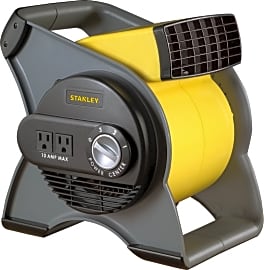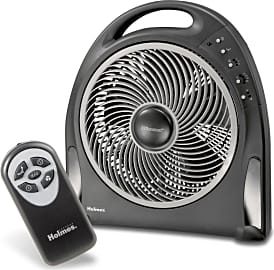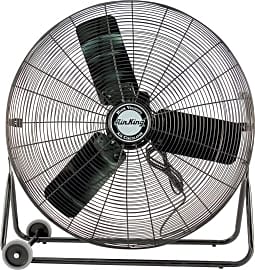The 10 Best Floor Fans

This wiki has been updated 36 times since it was first published in October of 2016. Ideal for providing additional cooling and airflow in garages, workshops, or the home, floor fans can help you beat the heat without resorting to cranking up an air conditioning unit, so not only are these practical, but they're also environmentally friendly. Plus, they offer portability that ceiling-mounted options don't. We've ranked them here by power, durability, and value. When users buy our independently chosen editorial recommendations, we may earn commissions to help fund the Wiki.
Editor's Notes
September 10, 2019:
There are many reasons you may need to add some more airflow to a room, so there is no single best method that suits every situation, but we think our list does a pretty good job of covering the variety of floor fan designs to address every need. If you have to dry a ceiling or circulate cold air at a higher altitude in the room, the Avalon Genesis A3, with its 360-degree pivoting head, as well as the Lasko Stanley 655704, which can be set at a 90-degree angle, will come in handy.
If you want great coverage all of your body, the Seville Classics UltraSlimline can do the job with its long tower design. The Rowenta VU5670 is also up to the challenge of sending a pleasant breeze towards the upper body, since it stands on a pole that can be adjusted from 42 to 54 inches.
When you need some serious cooling power for a space that gets particularly muggy like a warehouse, the industrial-grade Air King 9230 and the iliving BLDC Air Circulator are great selections. But if you just need something quaint for a bedroom, the Holmes 12-Inch Blizzard and Vornado 723DC are ideal. The Avalon Genesis A3 will come in handy in this setting, too, since it can easily sit on a floor or a desk.
Special Honors
The Quorum 35154-86 Mariana Though it is certainly not a budget item, this fan is ideal for those who like style to meet function since it's both a statement piece and a cooling device. Its oiled-bronze finish paired with the wooden tripod legs give it an industrial-chic aesthetic. Plus, it has a UL damp safety rating, making it suitable for areas that are subject to moisture. quorumlightinglights.com
The ULine Heavy-Duty Stationary Pedestal Ready for tougher jobs, this fan has a 1/2-horsepower motor and durable aluminum blades inside of its powder-coated steel guard. Its bright yellow color makes it easy to see, adding safety to a work space, while its ten-foot power cable should minimize the need for an extension cord. uline.com
It’s Cold Down There
Air conditioning units are notorious for drawing a tremendous amount of power, hurting both the bottom line of your household budget and the environment as a whole.
If you've ever had the displeasure of going up into the attic of a house on a warm summer's day, you may be familiar with the idea that heat rises. That attic space probably felt a good 10 or 15 degrees hotter than the rest of the house. This is one of the reasons that most attics are so heavily insulated.
The inverse of this experience is also true. If you've ever come home on a hot day and had to wait for the AC to cool down your space, you may have ventured down into the basement for a little relief. Now, part of the reason that the basement is a little cooler than the rest of the house is that it's underground, but it's also true that heat from the basement rises up into the main living space and eventually into the attic.
This particular law of thermodynamics, that heat rises, is something that you can actually use to your advantage on a hot day. To do so, you simply need to invest in a floor fan.
Window fans or box fans placed in a window do a fine job creating a cross-breeze, but if it's particularly hot outside this might not be the best solution. Air conditioning units are notorious for drawing a tremendous amount of power, hurting both the bottom line of your household budget and the environment as a whole. But at any given point in any room in the house, there's a disparity in the air temperature at the floor level when compared to the temperature closer to the ceiling, where our heads usually are. And while that disparity isn't tremendous, using a floor fan to whip up some of the cooler air around our feet and mix it with the hot air above can help make the room feel cooler.
Additionally, a floor fan is going to provide you with many of the same benefits as any other fan would, specifically in that it will increase the flow of air in a room. The rate at which air flows across a body of water directly affects the rate at which that water evaporates. Sweat, when thought of as a body of water, is designed to evaporate to keep you cool. So, when there is greater airflow around your body, and your body is sweating even in the slightest, you will feel cooler.
Choosing The Perfect Floor Fan
As you set out to choose a floor fan, you'll notice that there are several different varieties on the market. Some are much larger than others, and some seem to have almost industrial designs intended for a specific purpose. You'll also notice that this category sometimes includes standing floor fans, which are taller than the fans intended to sit on the floor, but which are also reliable for circulating air throughout a room.
Some fans allow you to tilt them at various angles, which can be helpful if you want to make sure you can feel the breeze from a certain point in the room.
If all you're looking to do is generate a little air current, and perhaps decrease the temperature in the space as described above, you can easily choose almost any fan on the list. Larger fans will tend to work better and larger spaces, however, so take into account the size of the room you want to cool off and make sure the fan you have your eye on is capable of handling it.
Some of the larger, more industrial-looking fans on our list are designed not only with cooling in mind, but also drying. As we mentioned above, airflow directly correlates to evaporation, so in some industrial settings where workers need paint to dry quickly, cleaning personnel need floors to dry quickly, or salvage crews need a previously flooded space to dry out, these types of fans are ideal. There's nothing to say they won't do a great job cooling off your room at home, but you may find them to be a little too large or a bit too loud for home use.
Once you know what kind of fan you want, you can look for other features. Some fans allow you to tilt them at various angles, which can be helpful if you want to make sure you can feel the breeze from a certain point in the room. Others also come with the ability to vary the speed of the blades at several settings. This is nice if you want to be able to control the intensity of the breeze, as well as the intensity of the sound your fan creates should you need to run it more quietly for a brief phone conversation.
Other Ways To Beat The Heat
A good floor fan is an excellent way to circulate the air in a space, and to help you feel a little less hot. There are a lot of additional tricks and tools you can employ to help beat the heat, however.
There are a lot of additional tricks and tools you can employ to help beat the heat, however.
For starters, it's vital both for your comfort and for your safety that you stay hydrated. When it gets hot out, your body needs to sweat to keep you cool, and if you don't have enough water to sweat sufficiently, you will feel the effects of dehydration in no time. Staying sufficiently hydrated, especially with a nice tall glass of ice water, will have a profound effect on your body temperature.
If the science of evaporation has you particularly captivated, you might want to add an evaporative cooler to your cooling strategies. These will create a cool breeze through evaporation that is significantly more cooling than a regular fan, though not so cooling as an air conditioner. Compared to an air conditioner, however, they use a heck of a lot less energy.
However you decide to keep cool, if you find your means are insufficient, there are likely a variety of cooling centers in your town or city that can keep you safe on the hottest of days. You can also always sneak off to the mall or the library, where you will reliably find comfortable air conditioning. And if you or anyone in the immediate vicinity of your neighborhood is at particularly high risk, whether they are elderly or infirmed, make a connection with them and offer to share your cooling prowess on the hottest of days.















